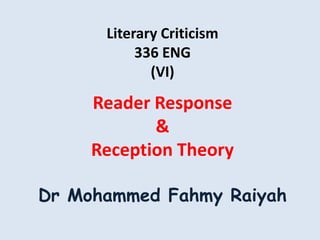Reader response and reception theory
•Download as PPTX, PDF•
24 likes•14,143 views
This document provides an overview of Reader Response theory and criticism. Some key points: 1) Reader Response criticism focuses on the reader's role in constructing the meaning of a literary work, as meaning does not reside solely in the text itself but depends on the reader's engagement. 2) This school of criticism emerged in the 1970s and is championed by theorists like Fish, Holland, Iser, and Rosenblatt. It positions the reader as an active participant rather than a passive recipient. 3) According to this view, different readers can generate multiple valid interpretations based on their own experiences and backgrounds, though interpretations must still be supported by evidence from the text.
Report
Share
Report
Share

Recommended
Recommended
More Related Content
What's hot
What's hot (20)
Similar to Reader response and reception theory
Similar to Reader response and reception theory (20)
Translingualism: Building a more Inclusive Writing Center

Translingualism: Building a more Inclusive Writing Center
21st Century Literature_Unit 1_Lesson 1_Literary Reading Through a Biographic...

21st Century Literature_Unit 1_Lesson 1_Literary Reading Through a Biographic...
21st-Century-Literature_Unit-1_Lesson-1_Literary-Reading-Through-a-Biographic...

21st-Century-Literature_Unit-1_Lesson-1_Literary-Reading-Through-a-Biographic...
More from Mohammed Raiyah
More from Mohammed Raiyah (20)
Recently uploaded
The Author of this document is
Dr. Abdulfatah A. SalemOperations Management - Book1.p - Dr. Abdulfatah A. Salem

Operations Management - Book1.p - Dr. Abdulfatah A. SalemArab Academy for Science, Technology and Maritime Transport
https://app.box.com/s/tkvuef7ygq0mecwlj72eucr4g9d3ljcs50 ĐỀ LUYỆN THI IOE LỚP 9 - NĂM HỌC 2022-2023 (CÓ LINK HÌNH, FILE AUDIO VÀ ĐÁ...

50 ĐỀ LUYỆN THI IOE LỚP 9 - NĂM HỌC 2022-2023 (CÓ LINK HÌNH, FILE AUDIO VÀ ĐÁ...Nguyen Thanh Tu Collection
Recently uploaded (20)
Home assignment II on Spectroscopy 2024 Answers.pdf

Home assignment II on Spectroscopy 2024 Answers.pdf
Operations Management - Book1.p - Dr. Abdulfatah A. Salem

Operations Management - Book1.p - Dr. Abdulfatah A. Salem
Jose-Rizal-and-Philippine-Nationalism-National-Symbol-2.pptx

Jose-Rizal-and-Philippine-Nationalism-National-Symbol-2.pptx
INU_CAPSTONEDESIGN_비밀번호486_업로드용 발표자료.pdf

INU_CAPSTONEDESIGN_비밀번호486_업로드용 발표자료.pdf
50 ĐỀ LUYỆN THI IOE LỚP 9 - NĂM HỌC 2022-2023 (CÓ LINK HÌNH, FILE AUDIO VÀ ĐÁ...

50 ĐỀ LUYỆN THI IOE LỚP 9 - NĂM HỌC 2022-2023 (CÓ LINK HÌNH, FILE AUDIO VÀ ĐÁ...
Basic phrases for greeting and assisting costumers

Basic phrases for greeting and assisting costumers
Adversarial Attention Modeling for Multi-dimensional Emotion Regression.pdf

Adversarial Attention Modeling for Multi-dimensional Emotion Regression.pdf
Basic Civil Engg Notes_Chapter-6_Environment Pollution & Engineering

Basic Civil Engg Notes_Chapter-6_Environment Pollution & Engineering
MARUTI SUZUKI- A Successful Joint Venture in India.pptx

MARUTI SUZUKI- A Successful Joint Venture in India.pptx
aaaaaaaaaaaaaaaaaaaaaaaaaaaaaaaaaaaaaaaaaaaaaaaaaaaaaaa

aaaaaaaaaaaaaaaaaaaaaaaaaaaaaaaaaaaaaaaaaaaaaaaaaaaaaaa
Benefits and Challenges of Using Open Educational Resources

Benefits and Challenges of Using Open Educational Resources
Reader response and reception theory
- 1. Literary Criticism 336 ENG (VI) Reader Response & Reception Theory Dr Mohammed Fahmy Raiyah
- 2. Preliminary Questions Are our responses to a literary work the same as its meaning(s)? Does meaning exist in the text? Can one literary work have many meanings? Are some interpretations more valid than others? Reader Response critics try to find answer to the above questions about the relationship between meaning and reading.
- 3. Introduction This approach focuses on the reader and his role in the making of a literary work. The text does not exist without the reader. Meaning of literary texts depends upon the reader’s engagement and interaction with them. The reader is an active participant in the production of meaning. This school of criticism emerged in the United States in the 1970s. Some major proponents of this approach include Norman Holland Stanley Fish Wolfgang Iser Hans-Robert Jauss Louise Rosenblatt David Bleich
- 4. Subjective vs Objective Reader Response was a reaction against the formalist approach that concentrates only on the text. It is subjective because it takes into consideration the personality of the reader and the ways he contributes to the making of the text. Reading reveals more about the reader’s personality than about the text.
- 5. The Text and Meaning Meaning does not solely reside in the text. Texts do not have meaning apart from the reader. Meaning is partly the result of the reader’s and interaction with and interpretation of the text. (The apple does not taste good if nobody tastes it.) Because the meaning of the text depends on the reader’s understanding of and feelings towards it, we can have more than one meaning, more than one valid interpretation.
- 6. The Reader The text remains incomplete without the reader. The reader is not the passive recipient of ideas included in the text by the author. He/she is active in giving meaning to the text. The reader’s life experiences, his/her personality, social and cultural background, education, gender, and personal taste influence his/her reading of the text.
- 7. + = TEXT + READER = MEANING
- 8. Limits of Interpretation Different interpretations – but not all - are valid as long as the reader can provide evidence in the text. In each text there are limits to its possible interpretations. For example, we cannot change the setting, the plot, or redefine the characters.
- 9. Textual Gaps Iser argues that texts contain gaps (or blanks) – things that are not expressed – which invite the reader to interfere actively in order to find their meaning.
